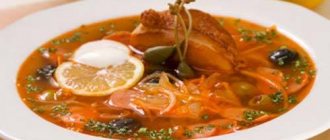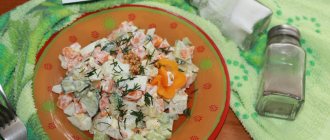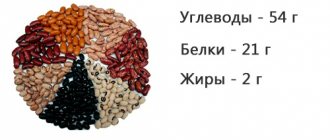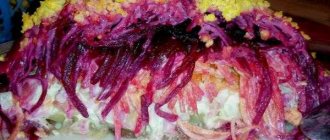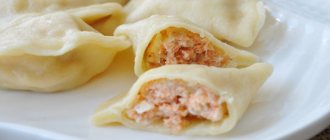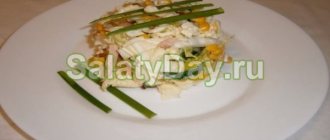2
Prepared by: Ekaterina Fesenko
07/02/2018 Cooking time: 1 hour 0 min
| Save | I cooked) | Estimate |
There is a very cool dish in American cuisine - rich, mouth-watering clam chowder. If you haven't tried it yet, I highly recommend taking note of the recipe and repeating it at home.
Ingredients:
- Chicken - 300-400 grams
- Onion – 1 piece
- Carrots – 1 piece
- Potatoes – 2 pieces
- Bell pepper – 1 piece
- Celery stalk – 1 piece
- Corn – 100 grams
- Garlic – 1-2 cloves
- Hot pepper – 1 piece
- Whole grain flour - 1-2 tbsp. spoons
- Salt - 1-2 pinches
- Bay leaf – 1 piece
- Cream - 150 Milliliters
- Butter – 40 grams
- Water – 2 Liters
Number of servings: 8
Soups of two cultures - American and Asian
We have already completed the first part of a culinary journey through the cuisines of the world to get acquainted with the famous soups. Let's continue our exciting voyage! We still have many discoveries ahead.
Gumbo
Gumbo soup is one of the main characters in the animated film "The Princess and the Frog" by Walt Disney Studios. In the fairy tale, soup has magical properties, allowing you to see the past and perform a miracle.
The soup comes from the US state of Louisiana. A bright representative of thick soups, which are either a soup or a liquid stew. In some ways it reflects the multinational culture of the country: the soup contains references to Spanish, African and Indian cuisine.
The name was given by one of the ingredients - the okra plant. In cooking, it is valued for its neutral taste, which means it is ideally compatible with other products, and for the mucous substances it contains - a natural thickener.
The two constants in gumbo are the roux and sassafras Creole seasoning. All other components depend on the preferences of the cook. Any type of meat, poultry or seafood, different types of vegetables. And if you're lucky enough to find it, okra.
Clam chowder
In the novel “Moby Dick, or the Brown Whale” by the writer Herman Melville, an entire chapter is dedicated to chowder: “Chowder for breakfast, chowder for lunch, chowder for dinner... And so on until fish bones are crawling out of you in all directions...”
New England gave the gastronomic world chowder with seafood and clam chowder. But the name has French roots. Fishermen from the province of Brittany cooked fish soup in special cauldrons called chaudier.
Like many other dishes, when it appeared, and this was about three hundred years ago, chowder was considered the soup of the poor. At first it was cooked from fish, then it was replaced by shellfish. Although the fish option - fish chowder - also remains. Bacon and saltine crackers are also essential ingredients.
The broth gets its thickness from the flour added to it, and the tenderness and creamy texture comes from the cream. It happens that flour is replaced with mashed potatoes.
There are many variations of the soup. The four most popular are:
– New England, highly traditional;
– Manhattan, they put tomatoes in it;
– Rhode Island, the broth remains clear;
– Florida, spicy, with chili pepper added to it.
In 1939, residents of Maine in New England petitioned the state to ban tomatoes from clam chowder. They were motivated by the fact that only the bad taste of New Yorkers was the reason for adding tomatoes to the classic soup recipe.
Fenesca
Another fish soup - this time from Ecuador. The soup is not just some kind of stew made from dried or salted fish - but practically a biblical symbol. The fact is that in the original recipe you need to use 12 types of legumes. Ecuadorians say that fish symbolizes Christ, and legumes symbolize the apostles. So feneska is a traditional soup that is definitely included in the Lent menu.
Pie floater
Joe Cocker, the famous blues and rock singer, was a devoted fan of Pie floater soup.
A very unusual pea soup from South Australia - the pie floats in the bowl like a float. No one knows exactly how the recipe came about. But at the end of the 19th century, The Melbourne Argus newspaper published an assumption that a careless cook had dropped the pie into a plate. He didn’t have time to think about how to rectify the situation, and he decided to serve the soup in this form. Not forgetting to add that he invented a new dish. In principle, the explanation is quite logical. Cooking knows many examples when an absurd accident becomes the moment of birth of a masterpiece. Australia is so proud of its gastronomic heritage that in 2003 it recognized the Pie floater as a national heritage. So when you eat this soup, don't forget that you are eating a legend.
Tom yum
The pride of Thai cuisine. Tom in translation means boil, yam means salad. In world practice they limit themselves to this name, but in Thailand itself they add a third part. She specifies the method of preparation: tom yum thale - with seafood, most often with shrimp; tom yam kai - with chicken. By the way, there really is something “salad” in the soup. Thai chefs mix all the ingredients like a salad and pour boiling broth over it.
It is believed that tom yam was invented in the 18th century. It became popular in the next century, during the reign of King Rama V, who loved this soup so much that he introduced it to the menu of the royal court.
Fo
Another representative of Asian cuisine that has overcome geographical boundaries is the Vietnamese pho soup. Chicken (pho ga), fish (pho ka) or beef (pho bo) are added to the broth and rice noodles. Garnish the soup with bean sprouts and lime leaves.
The soup is quite young by culinary standards: it is just over a hundred years old. It was invented in Hanoi. It is believed that the French had a hand in this, since Vietnam was a French colony. And it was the French who taught the Vietnamese to eat beef. Before them, cows were used exclusively as working animals. By the way, linguists claim that the name also has French roots: fau - fire. Pho received final recognition in the 20s of the 20th century, when a restaurant of the same name opened in Hanoi.
Miso soup
Well, how can we talk about Asia without remembering miso soup? According to traditions, which have special significance in Japan, it is served at the beginning of the meal - before the main course. Of course it is very tasty. But this does not explain its use. It's all about the medical properties. Miso soup activates digestion and promotes better absorption of nutrients from subsequent dishes. The name was given by the seasoning - miso, or soybean paste, which, according to historians, they learned to prepare before our era. Like tofu, also included in the soup, it is prepared on the basis of fermented beans, salt and water. Wakame seaweed and dashi broth are added to them. The latter is brewed from kombu (kelp) and niboshi (dried anchovies).
How to make Chicken Chowder
Let's prepare the ingredients.
Prepare chicken broth. Place the chicken in cold water. Bring to a boil, remove any foam that appears. Cook until done. For taste, add salt, bay leaf and carrots to the broth.
Fry onions and carrots in butter.
After 7-10 minutes, add corn.
Add hot and bell peppers to the saucepan. Cook over low heat, stirring occasionally.
A couple of minutes before cooking, add celery and garlic.
Pour in whole grain flour, mix everything, add broth and bring to a boil.
Chicken and broth are ready. Add potatoes and cook for 25 minutes. Next, add the vegetables from the saucepan to the pan. Cook everything together for 2-3 minutes. Cream can be added to the pot of soup or into a serving bowl for each person.
Chicken chowder is ready. Serve hot. Bon appetit!
Other options
Some restaurants prepare clam chowder according to their own original recipes, which does not fit any of the above options. Typically, the soup is served with either saltine crackers or octagonal crackers. Throughout the United States, clam chowder is often served on sourdough bread, especially in San Francisco, where sourdough bread has been a tradition since 1849.[5][6]
Fish chowder, a fish soup, is similar to clam chowder, but instead of shellfish, fish, most often cod, is used in the preparation. This soup is prepared with cream, fish, corn, and sometimes onions.
Description
While working on Nickelodeon's SpongeBob SquarePants, Carl Greenblatt sketched various characters in his own cartoon style.[1] The original idea was based on a "sorcerer's apprentice" style story like "The Sword in the Stone". The idea was changed so that the plot revolved around a chef who teaches cooking to his apprentice.
Chowder was not created based on any animal, but simply to create the image of a soft children's toy that you want to hug.[2] Greenblatt drew inspiration from both Richard Scarry, the popular American writer and animator, and Saturday Morning Cartoons.[2][3]
The character Schnitzel first appeared in sketch form in the late 1990s.
Greenblatt once pitched his idea to Cartoon Network; It took about two years before the series was approved for release, and another year before the pilot was released. The creator estimates that he spent seven years working on Chowder before it was aired.[1]
Episodes were released in seasons containing 20 half-hour episodes. In each episode, during the credits there is a 30-second insert with stop-motion animation. Episodes can be purchased from the iTunes store.
One of the show's unusual features is the patterns used for the characters' clothing and skin. The templates are designed at full screen size, then sent to production where the characters are adjusted so that the template pattern fills the clothing area. When using this technology, when a character moves, the pattern of his clothing does not move with him, but remains a static picture in the background. A similar technique was used in the game Monkey Island
and in the animated series "Mr. Bean".
The show is also known for the wide variety of styles used. This includes the use of watercolor and ink in addition to the classic pattern style. Still images of real food and character figures are also used; game scenes with the voices of show actors and dolls (both puppets and those that are worn on the hand). This was sometimes used in the animated series "Courage the Cowardly Dog". The series boasts one of the most numerous animation techniques used in a single episode.
